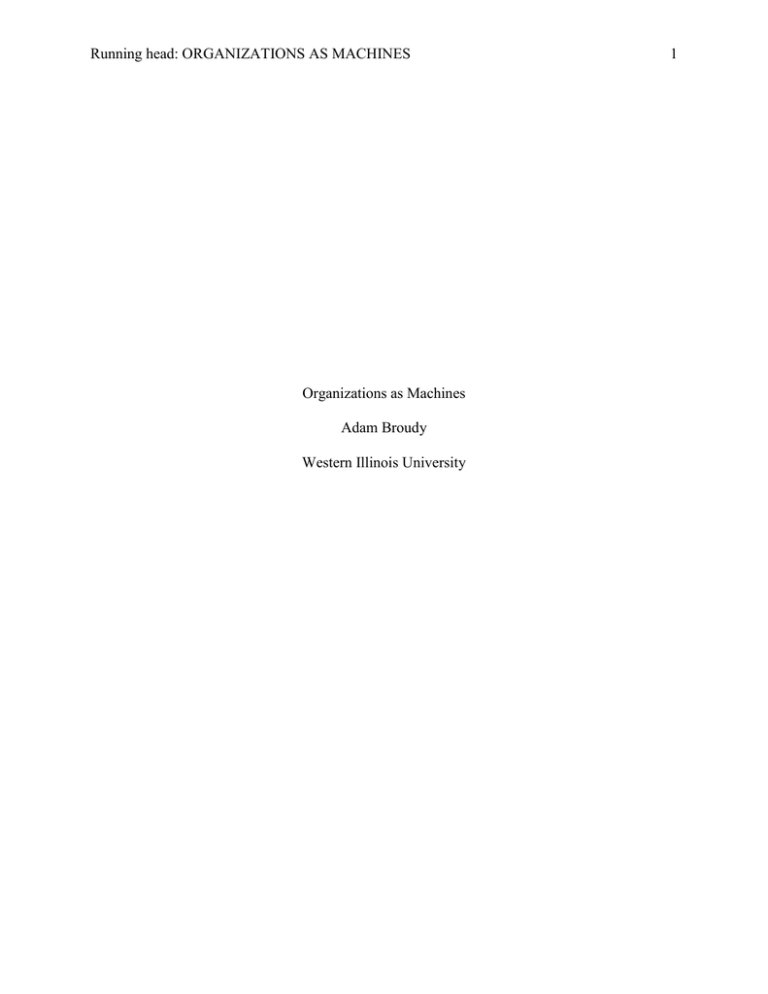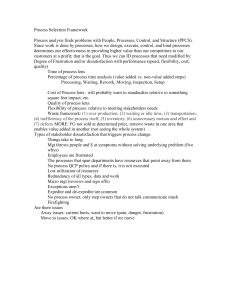File
advertisement

Running head: ORGANIZATIONS AS MACHINES Organizations as Machines Adam Broudy Western Illinois University 1 ORGANIZATIONS AS MACHINES 2 Organizations as Machines As I was reading Images of Organization by Gareth Morgan I found myself deep in thought about one point in particular as it relates to organizations as machines and the other metaphors we will be learning about throughout the semester. Morgan’s (2006) point is: “The use of metaphor implies a way of thinking and a way of seeing that pervade how we understand our world generally” (p. 4). Morgan (2006) goes on to explain that metaphors help to create valuable insights but are also incomplete and never give an all-purpose point of view. While looking through the lens of organizations as machines, I found it particularly helpful to keep this concept in mind. Definition and Assumptions About People Using the lens, organizations as machines, I see organizations as being heavily focused on routine, precision, reliability and efficiency. As I think about organizations as machines my mind flashes to a large public higher education institution where employees have a very specialized area to focus on. Each employee has their specific role that is essential for making the larger institution run with precision, reliability, and efficiency. Everything is precisely defined and controlled from the top-down. This lens is not focused on people and their needs. According to Morgan (2006), when organizations are run like machines the idea is “…to make humans fit the requirements of mechanical organization” (p. 22). The mentality that primarily goes into this lens with regard to people is that we are replaceable and if we do not get the job done, we will simply be replaced with someone who will. Workers are not to question why or how things are done, that is for management to handle. While this view would normally be sugarcoated to an extent it is the way organizations that are designed like machines run. Large fast food chains, grocery stores, and even higher educations work like machines to a large extent. ORGANIZATIONS AS MACHINES 3 Key Concepts The key concepts of this lens are that organizations should be run rationally and be primarily focused on operating in the most efficient manner possible. Ideally organizations will run like clockwork, similar to the McDonalds example in the text. Morgan (2006) explains that McDonalds has an “…emphasis on ruthless efficiency, quantification, predictability, control, and deskilled jobs (p. 24).” Some other key concepts include organizations be structured, have set goals, tasks, and objectives. Organizations from this lens are driven to meet and exceed the goals set forth. This lens neglects to seek out creative potential from employees since management works everything out and employees are just considered to be “manpower.” Outcomes From this lens, organizations that run in a streamlined and efficient manner will likely be the most profitable and be reliable. This is the ultimate goal. Organizations that can consistently do something well, will develop a niche and a certain area and will likely be successful in what they do. Organizations within this lens seek to have control over their market. Success is everything and to reach this outcome, organizations will do their best to create the most likely environment to reach this status. Strengths and Limitations Strengths of treating organizations as machines include providing clientele with clear cut expectations and creating new jobs. Reliability, routine, precision, and efficiency enables organizations to provide its customer base with a certain expectation. For example, when I go to McDonalds I have an expectation that the chicken nuggets I order will taste a specific way. This has been developed from my repeated encounters with the restaurant. Whether I visit, here in Macomb, or in California, McDonalds is generally reliable and the food tastes as expected. Organizations run as machines succeed based on its ability to repeatedly complete tasks in a ORGANIZATIONS AS MACHINES 4 precise way. Organizations that are run like machines have an innate ability to be successful and grow. My experiences have shown me that organizations that prioritize efficiency, precision, and reliability often are successful and able to expand. When these organizations grow, jobs are created. This is a huge positive for those looking for work. A limitation of treating organizations as machines include one size does not fit all and this often leads to a negative customer reaction. Machines are normally very good at only one thing. That thing may not work or meet the needs of everybody. This is a limitation because if the organization were more generalized and all-purpose it would likely better meet more of the needs of its consumer base. This lack of generalization can then therefore lead to a negative customer reaction. Outsourcing and large business are also turnoffs for many individuals. Lastly, as large mechanized organizations continue to grow so do automated systems. I know when I call a company such as UPS, I would greatly prefer to talk directly to another human. Instead, I go though 10 minutes in an automated system before I can get to that point. This can be a frustrating process. Past Experience My first job was working as a bagger at a Vons grocery store. Upon being trained it became clear that the company had a “recipe” for interactions with shoppers. First we were supposed to give a nice friendly greeting to customers whom we made eye contact with. This was followed by “are you finding everything okay?” If the customer asked for help we needed to escort them to the appropriate item or department. If they were checking out and they had more than one bag or appeared to need help we were to offer our assistance out to their vehicle. Lastly, we were supposed to end our interaction with a “Goodbye. Have a nice day!” Most things about that job were detailed and dictated to me. While reading about organizations as machines, this experience consistently popped into my head. Vons, like a ORGANIZATIONS AS MACHINES machine, was largely focused on consistency and reliability in the service and experience they provide to customers. My experience working at Vons definitely helped give me an understanding and a starting point for understanding organizations as machines. 5 ORGANIZATIONS AS MACHINES 6 References Morgan, G. (2006). Images of organization. Thousand Oaks, CA: Sage Publications, Inc.







